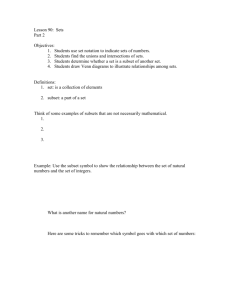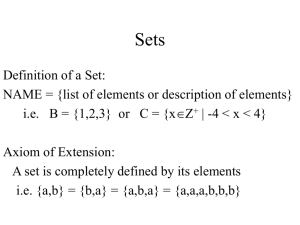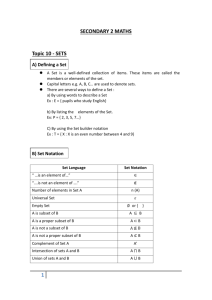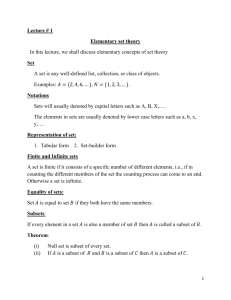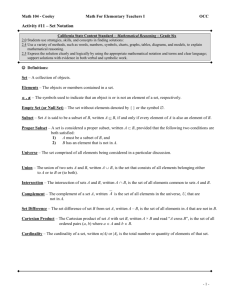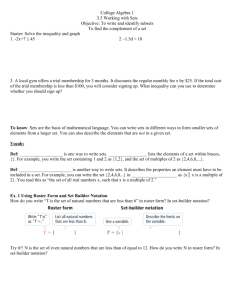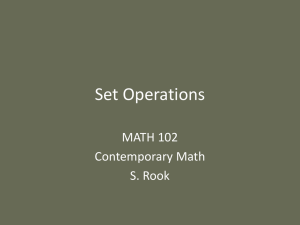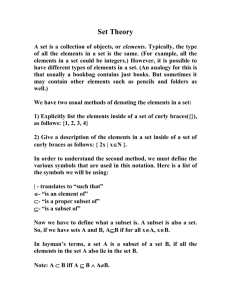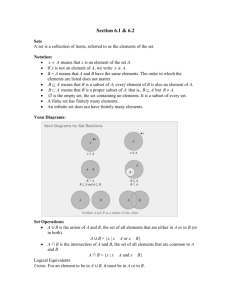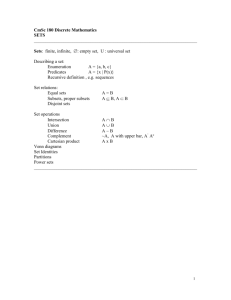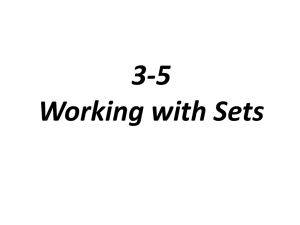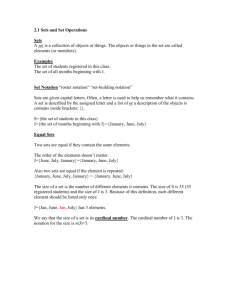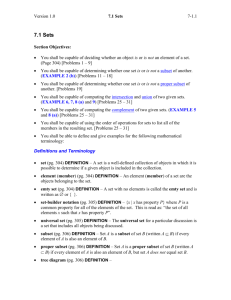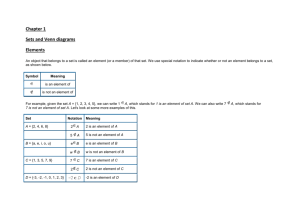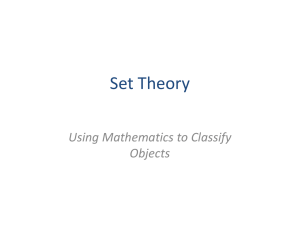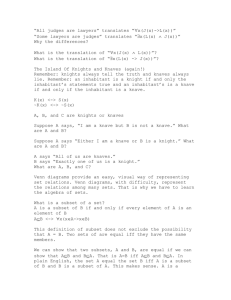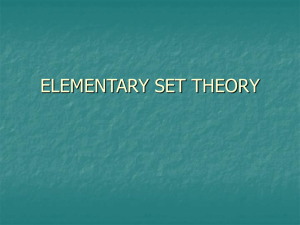Set Theory - homepages.ohiodominican.edu
advertisement
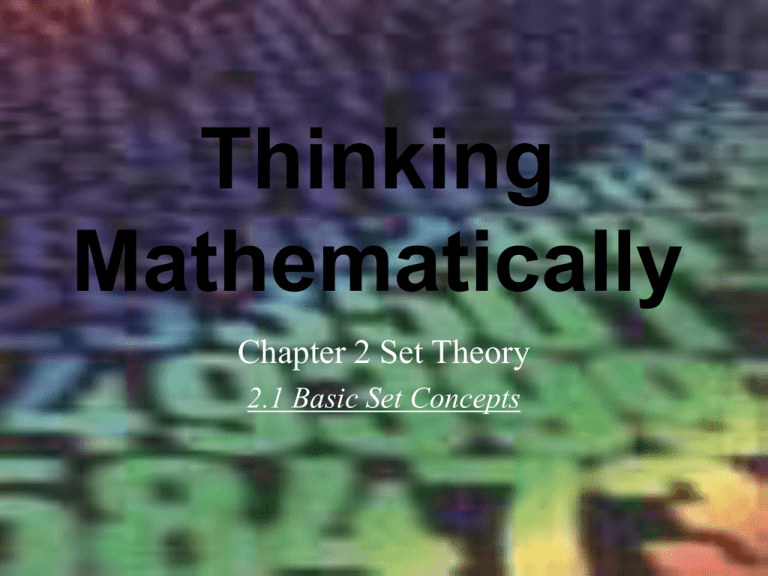
Thinking
Mathematically
Chapter 2 Set Theory
2.1 Basic Set Concepts
Basic Set Concepts
•A set is a collection of objects. Each object is
called an element of the set.
•A set must be well defined:
Its contents can be clearly determined
Its clear if an object is or is not a member of
the set.
Representing Sets
Word Description: Describe the set in
your own words, but be specific so the
elements are clearly defined.
Roster Method: List each element,
separated by commas, in braces.
Set-Builder Notation: {x | x is … word
description}.
The Set of Natural Numbers
N = {1,2,3,4,5,…}
This is an example of a set
We will be talking a lot more about sets of
numbers in Chapter 5
Examples: Representing Sets
Exercise Set 2.1 #3, 5, 13, 15, 25
• Well defined sets (T/F):
– The five worst U.S. presidents
– The natural numbers greater than one million
• Write a description for the set
{6, 7, 8, 9, …, 20}
• Express this set using the roster method:
The set of four seasons in a year.
{x | x N and x > 5 }
The Empty Set
The empty set, also called the
null set, is the set that contains
no elements.
The empty set is represented by
{ } or Ø
Examples: Empty Sets
Exercise Set 2.1 #35, 37, 41, 45
Which sets are empty
• {x | x is a women who served as U.S. president
before 2000}
• {x | x is the number of women who served as
U.S. president before 2000}
• {x | x <2 and x > 5}
• {x | x is a number less that 2 or greater than 5}
The Notation and
The symbol is used to indicate that
an object is an element of a set. The
symbol is used to replace the
words “is an element of”
The symbol is used to indicate that
an object is not an element of a set.
The symbol is used to replace the
words “is not an element of”
Example: Set elements
Exercise Set 2.1 #51, 59, 63 (T/F)
• 5 { 2, 4, 6, …, 20}
• 13 {x | x N and x < 13 }
• {3} {3, 4}
Definition of a Set’s Cardinal Number
The cardinal number of set A, represented
by n(A), is the number of distinct elements
in set A. The symbol n(A) is read “n of A”.
Repeated elements are not counted.
Exercise Set 2.1 #71
C = {x | x is a day of the week that begins with the letter A}
n( C) = ?
Definition of a Finite Set
Set A is a finite set if n(A) = 0 or n(A) is a
natural number. A set that is not finite is
called an infinite set.
Exercise Set 2.1 #91
{x | x N and x >= 100}
Finite or infinite?
Definition of Equality of Sets
Set A is equal to set B means that set A and
set B contain exactly the same elements,
regardless of order or possible repetition of
elements. We symbolize the equality of sets
A and B using the statement A = B.
Definition of Equivalent Sets
Set A is equivalent to set B means that set
A and set B contain the same number of
elements. For equivalent sets, n(A) = n(B).
Exercise Set 2.1 #85
A = { 1, 1, 1, 2, 2, 3, 4}
B = {4, 3, 2, 1}
Are these sets equal?
Are these sets equivalent?
Thinking
Mathematically
Chapter 2 Set Theory
2.3 Venn Diagrams and Set Operations
[we’ll come back to 2.2]
Definition of a Universal Set
A universal set, symbolized by U, is a set
that contains all of the elements being
considered in a given discussion or problem.
Exercise Set 2.3 #3
A = {Pepsi, Sprite}
B = {Coca Cola, Seven-Up}
Describe a universal set that includes all elements in sets A and B
Venn Diagrams
“Disjoint” sets have no
elements in common.
U
A
U
A
All elements of B are
also elements of A.
The sets A and B have
some common elements.
B
B
U
A
B
Definition of the Complement of a Set
The complement of set A, symbolized by
A´, is the set of all elements in the
universal set that are not in A.
This idea can be expressed in set-builder
notation as follows:
A´ = {x | x U and x A }.
Complement of a Set
U
A
A’
Example: Set Complement
Exercise Set 2.3 #11
U = {1, 2, 3,…, 20}
A = {1, 2, 3, 4, 5}
B = {6, 7, 8, 9}
C = {1, 3, 5, …, 19}
D = {2, 4, 6, …, 20}
´=?
C
Definition of Intersection of Sets
The intersection of sets A and B, written
AB, is the set of elements common to
both set A and set B. This definition can be
expressed in set builder notation as follows:
A B = { x | x A AND x B}
U
A
B
Definition of the Union of Sets
The union of sets A and B, written A B,
is the set of elements that are members of
set A or of set B or of both sets. This
definition can be expressed in set-builder
notation as follows:
A B = {x | x A OR x B}
U
A
B
The Empty Set in Intersection and
Union
For any set A:
1. A ∩ =
2. A = A
Examples: Union / Intersection
Exercise Set 2.3 #17, 19, 33, 35
U = {1, 2, 3, 4, 5, 6, 7}
A = {1, 3, 5, 7}
B = {1, 2, 3}
C = {2, 3, 4, 5, 6}
• AB=?
• AB=?
• A=?
• A∩ =?
Cardinal Number of the Union of
Two Sets
n(A U B) = n(A) + n(B) – n(A ∩B)
Exercise Set 2.3 #93
–
–
–
–
Set A 17 elements
Set B 20 elements
There are 6 elements common to the two sets
How many elements in the union?
Thinking
Mathematically
Chapter 2 Set Theory
2.2 Subsets
Definition of a Subset of a Set
Set B is a subset of set A, expressed as
BA
if every element in set B is also an element in set A.
U
A
B
Every set is a subset of itself: A A
Definition of a Proper Subset of a Set
Set B is a proper subset of set A, expressed
as B A, if set B is a subset of set A and
sets A and B are not equal ( A B ).
What is an improper subset?
The Empty Set as a Subset
1. For any set B, B.
2. For any set B other than the empty set,
B.
Example: Subsets
• Exercise Set 2.2 #3, 45, 43, 47
• {-3, 0, 3} ____ {-3, -1, 1, 3}
• (, , both, neither)
• {Ralph} {Ralph, Alice, Trixie, Norton}
(T/F)
• Ralph {Ralph, Alice, Trixie, Norton} (T/F)
• {Archie, Edith, Mike, Gloria} (T/F)
Thinking
Mathematically
Chapter 2 Set Theory
2.4 Set Operations and Venn Diagrams
With Three Sets
Example: Operations with three sets
Exercise Set 2.4 #3, 15
• U = {1, 2, 3, 4, 5, 6, 7} • U = {a, b, c, d, e, f, g, h}
A = {1, 3, 5, 7}
B = {1, 2, 3}
C = {2, 3, 4, 5, 6}
(A B) ∩ (A C)
A = {a, g, h}
B = {b, h, h}
C = {b, c, d, e, f}
(A B) ∩ (A C)
Example – Venn Diagrams
Exercise Set 2.4 #35, 37
U
A
B
4,5
1, 2, 3
7, 8
10, 11
6
9
12
13
AB=?
C
(A B)’ = ?
Example – Venn Diagrams
Exercise Set 2.4 #27, 29
U
A
I
II
B
III
IV V VI
VII
C
AC=?
A∩B=?
De Morgan’s Laws
(using Venn Diagrams as a proof)
• (A U B)' = A' ∩ B': The complement of the
union of two sets is the intersection of the
complement of those sets.
U
B
A
U
A
B
U
A
B
De Morgan’s Laws
• (A ∩ B)' = A' U B': The complement of the
intersection of two sets is the union of the
complement of those sets.
U
U
A
B
B
A
U
A
B
Examples: DeMorgan’s Laws
U = {1, 2, 3, 4, 5, 6, 7}
A = {1, 3, 5, 7}
B = {1, 2, 3}
• (A ∩ B) ' = ?
• A'UB'=?
Thinking
Mathematically
Chapter 2 Set Theory

